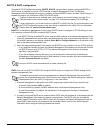
43InRow RC Operation and Maintenance Manual
Alarms do not show
up on monitoring
equipment (Customer
Output Contact)
• External monitoring equipment
is not receiving power or is not
functioning properly
• Confirm that power, if required, is being supplied to the
external equipment.
• If the cooling unit (+12 V or +24 V) is providing power to the
external equipment, verify that the external equipment is
<50 mA.
• Test the external equipment by bypassing the customer
output contact.
• Verify Customer Output Contact settings. See “Contacts” on
page 14.
Cooling unit does not
shut down on
command
• Drive voltage • Verify that there is a drive voltage entering the input of the
cooling unit. You may use the available +12 V or +24 V. You
must also use the ground.
• Verify Customer Input Contact settings. See “Contacts” on
page 14.
No communication
with building
management system
(BMS) port
• Improper connection • Confirm that the cooling unit is connected to the BMS port
and not to the Control port.
• Make sure that the wire polarity is correct. Using a DC
voltmeter, test the signal with no transmissions in progress.
Expect the voltage at pin 2 to be greater than at pin 1 by at
least 200 mV. Measure the cooling unit with the cable
disconnected, and then measure it again with the cable
connected. If the signal is less than 200 mV, the cooling unit
may be reverse-wired.
• Make sure that every cooling unit has either two sets of
wires in its connector or one set of wires and a terminating
resistor of 100 to 120 ohms.
Cooling units are not
communicating with
each other
• A-Link failure • Verify that the first and last cooling units have one cable and
a terminator.
• Verify that every other cooling unit has two cables.
• Confirm that the A-Link cables are connected to the A-Link
ports and that a network cable is connected to the network
port.
• Verify that the number of cooling units in the cooling group
matches the group number setting.
Output air is 17°C
(62°F) and fans are
running at a very high
rate of speed.
• Upper or lower supply air
sensor
• Either upper or lower supply air temperature sensor has a
fault. Verify that both supply air temperature sensors are
installed and working properly.
Problem Possible Cause Corrective Action


















